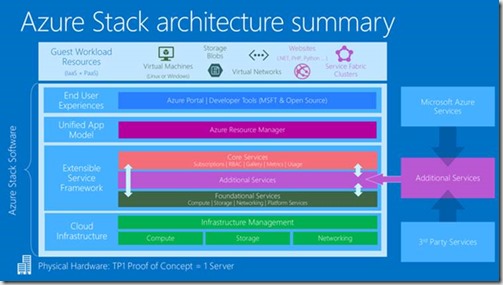Last Thursday at the MPUGUK session, I was speaking with someone who told me that the first slide of his presentation about Azure Stack had an image of a Rhino. According to him, Azure Stack is a combination of the “old” on-premises solutions (dinosaur) with the new and futuristic cloud services (unicorn), hence a rhino (dinosaur + unicorn) ![]()
So, what is this new option provided by Microsoft?
Azure Stack, currently in TP3, is nothing more nothing less than the Microsoft’s Azure cloud brought into a datacenter (running Microsoft’s Hyper-V, Windows, networking and storage). It is the first true private and hybrid cloud platform that benefits us with all the advantages of the Azure platform, but, keep the physical service in our facilities.
Architecturally speaking, Azure Public and Azure Stack are the same, which means the apps built on-premises can easily be shifted to the public azure cloud. This also means that the cloud services are finally available to the CFO’s that are reluctant to publish their instances in the cloud due to the “sensitive” nature of the information and all security and data governance concerns.
Another advantage of the Azure Stack, is the possibility of organisations that were stuck with the datacenter solutions, to benefit the capabilities of a public cloud.
Let’s consider the cruise industry example provided by Airlift. The cruise ships can only connect to the internet when they are near land, and even then, they don’t have enough bandwidth to run cloud services. To run their internal IT services on board, each ship has their own mini datacenter. With Azure Stack, they can now use services like Azure Bot Service to improve their customer service (eg. personalised marketing, digital and face recognition to access the cabins and make payments,etc.).
On the less bright side, we need to consider the limitations of this platform. A very obvious one, is the cost of the equipment (that can only be bought to DELL EMC, HPE, Lenovo and later in the year, Cisco) and all other costs associated to a datacenter.
Another downside is the elasticity and scalability limitations when comparing with Azure Public. Finally, the fact that Azure Public will always have more services than Azure Stack (the below image, shows the services that will be available in GA).
Regarding the pricing, just like Azure, we have the ability to start and stop services and will only pay for what we are using. Azure IaaS and PaaS services have no upfront fees, and use the same subscriptions, monetary commitments, and billing tools as Azure Public.
Additional sources:





Introduction to Data Wrangler in Microsoft Fabric
What is Data Wrangler? A key selling point of Microsoft Fabric is the Data Science
Jul
Autogen Power BI Model in Tabular Editor
In the realm of business intelligence, Power BI has emerged as a powerful tool for
Jul
Microsoft Healthcare Accelerator for Fabric
Microsoft released the Healthcare Data Solutions in Microsoft Fabric in Q1 2024. It was introduced
Jul
Unlock the Power of Colour: Make Your Power BI Reports Pop
Colour is a powerful visual tool that can enhance the appeal and readability of your
Jul
Python vs. PySpark: Navigating Data Analytics in Databricks – Part 2
Part 2: Exploring Advanced Functionalities in Databricks Welcome back to our Databricks journey! In this
May
GPT-4 with Vision vs Custom Vision in Anomaly Detection
Businesses today are generating data at an unprecedented rate. Automated processing of data is essential
May
Exploring DALL·E Capabilities
What is DALL·E? DALL·E is text-to-image generation system developed by OpenAI using deep learning methodologies.
May
Using Copilot Studio to Develop a HR Policy Bot
The next addition to Microsoft’s generative AI and large language model tools is Microsoft Copilot
Apr